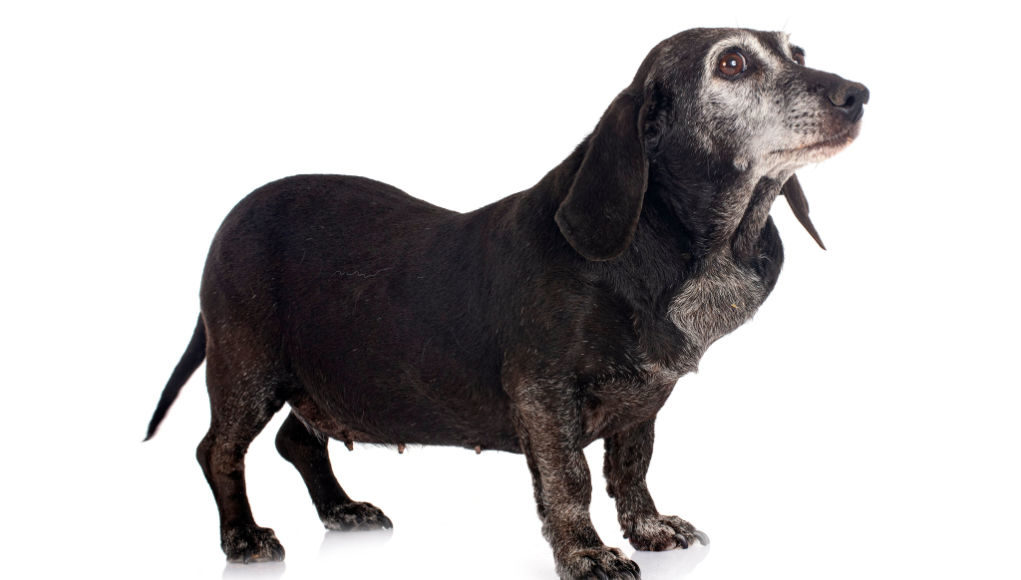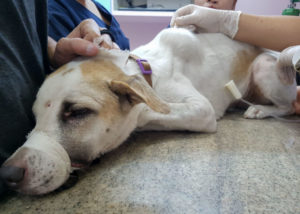Table of Contents
Like us humans, dogs are also susceptible to getting different diseases like cancer, and one of the most significant and most common is lymphoma in dogs.
According to the US Food and Drug Administration, although there are less than 70,000 dogs in the country that are getting diagnosed with lymphoma every year, it still accounts for 24% of new cancers in dogs.
Lymphoma in Dogs, also known as Canine Lymphosarcoma, is a type of cancer that commonly occurs in organs responsible for the immune system.
It is considered a systematic disease. It affects the whole body because it develops in cells that are in the blood (known as lymphocytes).
In this article, let's dig a little deeper on what are the common types and symptoms of lymphoma in dogs.
We also listed down the possible treatments for lymphoma, and what can we do as dog parents in case of this unfortunate event.
Lymphoma in Dogs: Causes
Dogs are also exposed to the same environment as us. And what might be causing cancer in humans can be the same for dogs, too.
However, Lymphoma has no known cause as of yet.
Many studies and research were conducted to determine if lymphoma in dogs could be caused by viruses, bacteria, chemical exposures, or even strong magnetic fields, but none of them really came through.
As of now, what's constantly observed is having a low immune system is a risk factor in getting lymphoma (not only for dogs but humans too!).
But the connection between the low immune system and lymphoma hasn't been clearly established yet.
Lymphoma in Dogs: Types
Studies suggest that there are 30 types of canine lymphoma and that they vary in behavior depending on the affected organ.
However, they are categorized into 4 types of lymphoma in dogs:
- Multicentric or Systematic Lymphoma (begins on lymph nodes in multiple places)
- Alimentary or Gastrointestinal Lymphoma (found on stomach and/or intestines)
- Mediastinal Lymphoma (found on organs in the chest area)
- Extranodal Lymphoma (targets specific organs such as the skin, eyes, kidney, lungs, or the central nervous system.
One common extranodal type is Cutaneous Lymphoma. It usually appears as either lesions or rashes that are often itchy, scaly, and red to purple in color.
 Lymphoma in Dogs: Symptoms
Lymphoma in Dogs: Symptoms
Depending on the affected area, there are different signs and symptoms of lymphoma in dogs.
Multicentric Lymphoma
Swollen lymph nodes in dogs are the most noticeable sign of Multicentric Lymphoma.
Although it's generally not painful for them, the rapid growth of lymph nodes can be quite disturbing and worrisome.
They can grow from 3 to 10 times their normal size. They would also feel like a moving hard, rubbery lump under the skin.
At times, they may cause our dogs' loss of appetite and energy. You may also observe edema or swelling in the legs and/or face.
Alimentary Lymphoma
Alimentary Lymphoma mainly affects our dog's gastrointestinal organs. Because of this, some symptoms you'll probably observe are vomiting, diarrhea, weight loss, and abdominal pain.
Their diarrhea can be quite watery, dark in color, and foul-smelling.
Now I know it's hard to notice if your dog has an aching tummy (if only they can speak!)
But if you see them restless, in a scrunched-up position, and don't like getting touched in the abdomen area, then that could be abdominal pain.
Mediastinal Lymphoma
Because it's in the chest area, Mediastinal Lymphoma may cause difficulty in breathing in our dogs.
Also some of the most noticeable signs are constant coughing and their intolerance to physical activities.
Dogs with this type of lymphoma may also get swelling in the face and in their front legs.
You'll also notice them frequently thirsty and always urinating.
Extranodal Lymphoma
Since Extranodal Lymphoma targets different organs, you may want to keep a look out for different symptoms.
Lymphoma on the skin may appear as either lesions or rashes, while lymphoma on the eyes may start as blindness.
Sudden seizures may be caused by lymphoma in their central nervous system, and unexplained fractures may be caused by lymphoma on their bones.
Whatever unusual symptoms you may be observing in your dog, consulting your vet is always, always the best thing to do.
Lymphoma in Dogs: Diagnosis and Prognosis
How to Diagnose Lymphoma in Dogs?
There are a couple of diagnostic tests your provider may order to help diagnose that unexplained lump or sudden changes in your dog's demeanor.
The tests can include fine needle aspiration, biopsy, and clinical staging tests.
Once diagnosed, several additional tests may also be conducted to help with their prognosis and treatment.
Fine Needle Aspiration
The earliest test your vet may do is Fine Needle Aspiration.
Here, a needle (often the same size used in vaccination, don't worry!) will be inserted into the swollen lymph node to get a sample cell.
This will be further examined under a microscope to check for evidence of whether it is cancerous or not.
Internal organs that may appear abnormal on other diagnostic tests may also be sampled with a small needle.
Biopsy
If the aspiration didn't quite get what the vet is looking for, he may order a biopsy.
Here, a tissue sample will be removed via minor surgery. It could be done thru a Tru-cut needle biopsy, incisional wedge biopsy, or the removal of an entire lymph node aka excisional biopsy.
Just a heads up though, lymphomas on the intestine or the skin can definitely require a biopsy.
Clinical Staging Tests
This involves the usual routine blood work, chest X-rays, abdominal ultrasound, and even bone marrow aspiration.
These clinical staging tests are important not only to determine if the lymphoma has possibly spread to other organs.
It's also to prevent other complications from happening once you pursue the treatment of lymphoma in your dog.
Additional tests
If your dog has been diagnosed with lymphoma (hugs!), a couple more additional tests are needed to distinguish the type of affected cells, whether it's the B-cell or the T-cell.
They're either the Immunohistochemistry test or Flow Cytometry test.
Either test will help provide more information about your dog's prognosis.
What is the Common Prognosis for Lymphoma in Dogs?
One of the frequently asked questions about lymphoma in dogs is the life expectancy—how long can a dog live with lymphoma?
Dogs that are diagnosed with the disease can have a life expectancy of 1 to 2 months if untreated.
Luckily, there are several cancer treatments you can choose from to help prolong your dog's life.
And another heads up, lymphoma in dogs is never truly cured–it can only go into remission.
But before you lose hope, let me explain.
Remission means all signs and symptoms of cancer in your dogs are either partially reduced or completely reduced.
This means the cancer cells may still be present, but their effects on your dog are not as evident as before.
Experts may even call complete remission NED or No Evidence of Disease. However, this is still not quite the same as being cured.
Remission means there's still a possibility of relapse; the cancer cells may go back after some time and attack other healthy cells again.
Lymphoma in Dogs: Treatment
Like in humans, there are a couple of options to help manage lymphoma in dogs.
There's chemotherapy, radiation therapy, surgery, and even oral steroids aka prednisone.
With the proper treatment, 85% of dogs with lymph node involvement can go into remission (that's a promising number!)
Chemotherapy
Chemotherapy is considered to be the most successful procedure in helping fight off cancer cells in the body.
In fact, with chemo, your dog can survive for another 6 to 12 months, and with continuous treatment, it can go into remission for 8 to 9 months.
Your dog will be given a weekly dose of injection to fight off the cancer cells. It may also be combined with other medication or procedures known as combination chemotherapy.
Now thankfully, dogs don't seem to get affected much by chemo, unlike humans.
They don't shed too much hair but some side effects may still include vomiting, diarrhea, and a decrease in appetite and activity levels.
Radiation Therapy
Radiation therapy can be done for low-grade localized lymphoma. That means it can target only a specific area in your dog's body where the cancer cells are running rampant.
It can be used as a treatment on its own, but will mostly be combined with chemotherapy since lymphoma is a systematic disease.
Depending on your dog's response to radiation therapy, it can definitely add to the remission and survival time of your dog.
Surgery
Along with chemotherapy and radiotherapy, surgery is another option you and your vet may consider.
However, just like with radiation therapy, this will only be applicable to low-grade and localized lymphoma.
For example, single lesions caused by cutaneous lymphoma may be removed surgically if the cancer is only contained in that area.
But if it turns out the lymphoma has already spread to other parts of the body, then chemotherapy will still be the best option for treatment.
Oral Steroid
The vet can also prescribe prednisone, a type of steroid anti-inflammatory oral medication, to reduce your dog's pain, stress, and symptoms.
Sadly, we all know how expensive chemos could get so some dog owners opt for only this due to financial constraints.
It's important to note, however, that prednisones alone cannot treat lymphoma. At most, it can only provide a temporary reduction to the clinical signs and buy your dog some time for about 4 to 6 weeks.
Lymphoma in Dogs: Cost
The average cost of lymphoma treatment in dogs varies based on the procedure and your location.
According to the Veterinary Cancer Society, initial consultation for a vet-oncologist can range from $125 to $250.
Chemotherapy can go from $150 to $600 per dose depending on the drug and whether it's oral or IV. That should also include the recheck exam, blood work, chemo prep, and administration costs for every visit.
Radiation therapy may cost from $1000 for palliative purposes to $6000 for curative protocols.
Surgeries, on the other hand, really depend on how complicated the procedure could be; your vet-surgeon can give you the estimated amount for this.
In the end, it's best to have an extensive talk with your trusted vet and the whole family regarding the cost of treatment for your dog's lymphoma.
Lymphoma in Dogs: What Can I Do?
As a dog parent, I know how emotionally draining it can be upon learning that your dog is suffering from a sickness we can only wish to take away from them.
Be proactive with your dog's treatment. Maybe, there are ongoing clinical trials on veterinary cancer research in the university, hospital, or clinic near your area, it's worth checking!
You can also get a second opinion if you feel like it. Ask your vet for a referral to a board-certified specialist or you may go ahead and contact a vet-oncologist yourself.
It's also worth checking if your dog's insurance can cover lymphoma in dogs. But if there's no insurance yet, maybe it's not too late to get one. It's best to talk to a pet insurance agent.
Since there's no known way to prevent lymphoma in dogs, we can only hope for the best and prepare for the worst.
Just keep an open mind with the prognosis your vet may give your dog, and remember that there are options!
Lymphoma in Dogs Summary
Lymphoma in dogs is considered one of the most common canine cancers, but that only means treatments are widely available and are not unprecedented.
This article can only give you a rough idea of the lymphoma symptoms, prognosis, and treatment options for possible cancer in your dog.
If you are only seeing some signs now in your dog, try to address their discomfort immediately by booking an appointment with your vet.
But if a diagnosis has been made already and your dog is indeed positive for lymphoma, don't lose hope!
You are not alone.
Your family, your trusted vet, and even us at Top Dog Tips are your teammates. We all want what's best for your fur baby.















